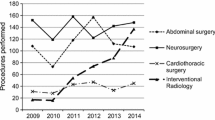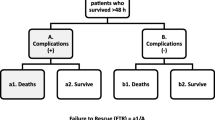Abstract
Introduction
The rate of potentially preventable deaths (PPD) and preventable deaths (PD) can reach more than 20% of overall trauma mortality. Bleeding is the leading cause of preventable mortality. The aim of our study is to define the independent factors of preventable or potentially preventable mortality in our mature trauma system.
Materials and methods
We conducted a single-center retrospective study in the Sainte Anne Military Teaching Hospital, Toulon, France, including all severe trauma patients admitted to our trauma center and discharged alive as well as all severe trauma patients who died with a death considered preventable or potentially preventable from January 2013 to December 2020. We matched the two groups using a propensity score and searched for independent factors using a generalized linear model.
Results
846 patients were included and analyzed. After matching, our cohort consisted of 245 patients in the survivor group and 49 patients in the preventable deaths group. Pre-hospital delays (73 min vs 54 min P = 0.003) as well as delays before incision in the operating room (80 min vs 52 min P < 0.001) were significantly longer in the PD group. These delays were independent factors of preventable mortality OR 10.35 (95% CI [3.44–31.11] P < 0.001) and OR 37.53 (95% CI [8.51–165.46] P < 0.001) as well as pelvic trauma OR 6.20 (95% CI [1.53–25.20] P = 0.011).
Conclusion
Delays in pre-hospital care, delays in access to the operating room from arrival at the trauma center, and pelvic injuries are independent factors associated with an increased risk of preventable mortality in trauma.



Similar content being viewed by others
References
Spahn DR, Bouillon B, Cerny V, Duranteau J, Filipescu D, Hunt BJ, et al. The European guideline on management of major bleeding and coagulopathy following trauma; fifth edition. Crit Care BioMed Central. 2019;23:98–74.
Hakkenbrak NAG, Mikdad SY, Zuidema WP, Halm JA, Schoonmade LJ, Reijnders UJL, et al. Preventable death in trauma: A systematic review on definition and classification. Injury. 2021;52:2768–77.
Cameron PA, Gabbe BJ, Cooper DJ, Walker T, Judson R, McNeil J. A statewide system of trauma care in Victoria: effect on patient survival. Med J Aust. 2008;189:546–50.
Gabbe BJ, Simpson PM, Sutherland AM, Wolfe R, Fitzgerald MC, Judson R, et al. Improved functional outcomes for major trauma patients in a regionalized, inclusive trauma system. Ann Surg. 2012;255:1009–15.
MacKenzie EJ, Rivara FP, Jurkovich GJ, Nathens AB, Frey KP, Egleston BL, et al. A national evaluation of the effect of trauma-center care on mortality. N Engl J Med. 2006;354:366–78.
Nathens AB, Jurkovich GJ, Cummings P, Rivara FP, Maier RV. The effect of organized systems of trauma care on motor vehicle crash mortality. JAMA Am Med Assoc. 2000;283:1990–4.
Drake SA, Holcomb JB, Yang Y, Thetford C, Myers L, Brock M, et al. Establishing a regional trauma preventable/potentially preventable death rate. Ann Surg. 2020;271:375–82.
Guigues S, Cotte J, Morvan J-B, de Lesquen H, Prunet B, Boutonnet M, et al. Analysis of mortality over 7 years in a mature trauma center: evolution of preventable mortality in severe trauma patients. Eur J Trauma Emerg Surg. 2023;49:1425–31.
Surg SAJTAC. American College of Surgeons' Committee on Trauma, International, ATLS, working group. In: Advanced trauma life support (ATLS (R)): the ninth edition (2013).
Schluter PJ, Nathens A, Neal ML, Goble S, Cameron CM, Davey TM, et al. Trauma and Injury Severity Score (TRISS) coefficients 2009 revision. J Trauma. 2010;68:761–70.
Sartorius D, Le Manach Y, David J-S, Rancurel E, Smail N, Thicoïpé M, et al. Mechanism, glasgow coma scale, age, and arterial pressure (MGAP): a new simple prehospital triage score to predict mortality in trauma patients. Crit Care Med. 2010;38:831–7.
Baker SP, O’Neill B, Haddon W, Long WB. The injury severity score: a method for describing patients with multiple injuries and evaluating emergency care. J Trauma. 1974;14:187–96.
Tile M. Acute pelvic fractures: I. Causation and classification. J Am Acad Orthop Surg. 1996;4:143–51.
Cayten CG, Stahl WM, Agarwal N, Murphy JG. Analyses of preventable deaths by mechanism of injury among 13,500 trauma admissions. Ann Surg. 1991;214:51–521.
Oyeniyi BT, Fox EE, Scerbo M, Tomasek JS, Wade CE, Holcomb JB. Trends in 1029 trauma deaths at a level 1 trauma center: Impact of a bleeding control bundle of care. Injury. 2017;48:5–12.
Eriksson J, Nelson D, Holst A, Hellgren E, Friman O, Oldner A. Temporal patterns of organ dysfunction after severe trauma. Crit Care BioMed Central. 2021;25:165–211.
Cole E, Gillespie S, Vulliamy P, Brohi K, Organ Dysfunction in Trauma (ORDIT) study collaborators. Multiple organ dysfunction after trauma. Br J Surg. 2020;107:402–12.
Kotwal RS, Howard JT, Orman JA, Tarpey BW, Bailey JA, Champion HR, et al. The effect of a golden hour policy on the morbidity and mortality of combat casualties. JAMA Surg. 2016;151:15–24.
Travers S, Carfantan C, Luft A, Aigle L, Pasquier P, Martinaud C, et al. Five years of prolonged field care: prehospital challenges during recent French military operations. Transfusion. 2019;59:1459–66.
Yeguiayan J-M, Garrigue D, Binquet C, Jacquot C, Duranteau J, Martin C, et al. Medical pre-hospital management reduces mortality in severe blunt trauma: a prospective epidemiological study. Crit Care BioMed Central. 2011;15:R34–R11.
Neal MD, Reynolds BR, Bertoty D, Murray KJ, Peitzman AB, Forsythe RM. Design and implementation of the Western Pennsylvania regional Stop the Bleed initiative. J Trauma Acute Care Surg. 2018;85:684–90.
Gupta A, Villegas CV, Rosenberg J, Winchell RJ, Barie PS, Narayan M. Advancing the education of stop the bleed: development of a perfused synthetic cadaver model. J Surg Res. 2019;244:516–20.
Carmichael H, Steward L, Peltz ED, Wright FL, Velopulos CG. Preventable death and interpersonal violence in the United States: who can be saved? J Trauma Acute Care Surg. 2019;87:200–4.
Smith ER, Sarani B, Shapiro G, Gondek S, Rivas L, Ju T, et al. Incidence and cause of potentially preventable death after civilian public mass shooting in the US. J Am Coll Surg. 2019;229:244–51.
Oliver GJ, Walter DP, Redmond AD. Are prehospital deaths from trauma and accidental injury preventable? A direct historical comparison to assess what has changed in two decades. Injury. 2017;48:978–84.
Meizoso JP, Ray JJ, Karcutskie CA, Allen CJ, Zakrison TL, Pust GD, et al. Effect of time to operation on mortality for hypotensive patients with gunshot wounds to the torso: the golden 10 minutes. J Trauma Acute Care Surg. 2016;81:685–91.
Barbosa RR, Rowell SE, Fox EE, Holcomb JB, Bulger EM, Phelan HA, et al. Increasing time to operation is associated with decreased survival in patients with a positive FAST examination requiring emergent laparotomy. J Trauma Acute Care Surg. 2013;75:S48-52.
Chang R, Kerby JD, Kalkwarf KJ, Van Belle G, Fox EE, Cotton BA, et al. Earlier time to hemostasis is associated with decreased mortality and rate of complications: results from the pragmatic randomized optimal platelet and plasma ratio trial. J Trauma Acute Care Surg. 2019;87:342–9.
Watanabe H, Shimojo Y, Hira E, Kuramoto S, Muronoi T, Oka K, et al. First establishment of a new table-rotated-type hybrid emergency room system. Scand J Trauma Resusc Emerg Med. 2018;26:80–4.
Founding members of the Japanese Association for Hybrid Emergency Room System (JA‐HERS). The hybrid emergency room system: a novel trauma evaluation and care system created in Japan. Acute Med Surg. 2019;6:247–51.
Schulman JE, O’Toole RV, Castillo RC, Manson T, Sciadini MF, Whitney A, et al. Pelvic ring fractures are an independent risk factor for death after blunt trauma. J Trauma. 2010;68:930–4.
Palmcrantz J, Hardcastle TC, Naidoo SR, Muckart DJJ, Ahlm K, Eriksson A. Pelvic fractures at a new level 1 trauma centre: who dies from pelvic trauma? The Inkosi Albert Luthuli Central Hospital experience. Orthop Surg. 2012;4:216–21.
Perumal R, Dabadie CR, Soussan PS, Jayaramaraju D, Sen RK, Trikha V. Management of pelvic injuries in hemodynamically unstable polytrauma patients—challenges and current updates. J Clin Orthop Trauma. 2021;12:101–12.
Scemama U, Dabadie A, Varoquaux A, Soussan J, Gaudon C, Louis G, et al. Pelvic trauma and vascular emergencies. Diagn Interv Imaging. 2015;96:717–29.
Hundersmarck D, Hietbrink F, Leenen LPH, Heng M. Pelvic packing and angio-embolization after blunt pelvic trauma: a retrospective 18-year analysis. Injury. 2021;52:946–55.
Harmsen AMK, Giannakopoulos GF, Moerbeek PR, Jansma EP, Bonjer HJ, Bloemers FW. The influence of prehospital time on trauma patients outcome: a systematic review. Injury. 2015;46:602–9.
Funding
This study did not receive any financial assistance.
Author information
Authors and Affiliations
Contributions
MC, JB, and MR design the study. MC is its guarantor. MR, SG, and HM managed the data collections. MC, QM, and HM established and managed the statistical analysis. All the authors have contributed to write the manuscript and approved the final manuscript.
Corresponding author
Ethics declarations
Conflict of interest
The authors declare that they have no competing interests. The publication has not been published elsewhere.
Rights and permissions
Springer Nature or its licensor (e.g. a society or other partner) holds exclusive rights to this article under a publishing agreement with the author(s) or other rightsholder(s); author self-archiving of the accepted manuscript version of this article is solely governed by the terms of such publishing agreement and applicable law.
About this article
Cite this article
Robaix, M., Mathais, Q., de Malleray, H. et al. Independent factors of preventable death in a mature trauma center: a propensity-score analysis. Eur J Trauma Emerg Surg 50, 477–487 (2024). https://doi.org/10.1007/s00068-023-02367-w
Received:
Accepted:
Published:
Issue Date:
DOI: https://doi.org/10.1007/s00068-023-02367-w




